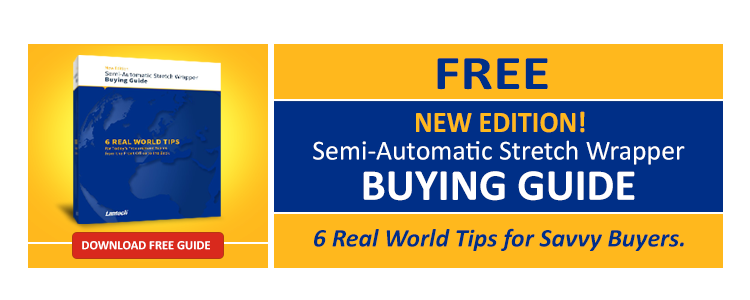Thinking of buying a stretch wrap machine? Should you buy new or look for a used one? Do you like the idea of knowing no one else has used your equipment or does the lower cost and depreciation appeal of a used machine get you interested?
 People buy machines appropriate for their application. Companies do not usually scale up and transition from hand wrapping to automatic wrapping over time. They build a line to accommodate a certain production capacity and then determine the pallet wrapping method and machine to fit it.
People buy machines appropriate for their application. Companies do not usually scale up and transition from hand wrapping to automatic wrapping over time. They build a line to accommodate a certain production capacity and then determine the pallet wrapping method and machine to fit it.
The semi-automatic market is larger than the automatic stretch wrapper market for a variety of reason including lower equipment costs and the fact that most production lines do not have enough output to require an automatic stretch wrapping solution. So there are many more used semi-automatic stretch wrappers than automatics available.
Buying a Used Stretch Wrapper Pros and Cons
The overwhelming reason to buy a used stretch wrapper is price. A new semi-automatic stretch wrapper runs in the $10,000 to $12,000 range while a used one is in the $3,000 to $6,000 range.
A used machine may be a good deal if it is relatively new. Risk will go up with age and use so factoring in potential repair and replacement part costs is critical. Used machines will typically be out of warranty so any maintenance and repair costs can make that used machine price less attractive pretty quickly.
For used semi-automatic machines:
- Pro – 30-60% of cost of new machine
- Pro – up and running quickly
- Con – risk of repair, especially around film delivery system and pre-stretch
- Con – no warranty
- Con – lower productivity than a new machine
- Con – less support for troubleshooting and optimizing performance
Automatic stretch wrappers present their own set of unique questions. An automatic stretch wrapping machine is more complicated so in terms of repairs there is more potential risk. Due to the increased machine complexity and set up requirements there are many potential subtle issues with a used machine that are not always apparent.
Potential issues with automatic stretch wrapping machines include:
- Probably will not include the latest technical innovations (could have a major impact on total cost of ownership)
- Peripheral elements like the pallet, pallet board orientation, is it perpendicular or parallel to rollers, if it is wrong you have to re-build machine
- Conveyor spacing
- Does the machine load from end or the sides? Side loading needs longer conveyors
- What is the flow direction? Does the pallet come from left or right?
- What is the pass height? From the top of roller to the ground is typically 18″, do the conveyor and machine match?
- Special applications like corner board placers, top sheet placers, short load logic (load below load height sensor for example) all create unique engineering problems that need to be solved.
For automatics the engineering value delivered by the manufacturer is not always apparent in just the machine, end users need to know the context of their wrapping environment to determine if a used machine is going to work for them.
One final note of caution, the 2016 Plant Engineering Maintenance Survey found that 50% of all unscheduled downtime results from aging equipment. Lack of maintenance (due to various factors from budget to manpower) accounted for another 25%.
Used vs New Equipment is a classic risk/reward decision, choose your stretch wrap machine wisely.
This post was published on August 25, 2016 and updated on April 13, 2017.
August 25, 2016

